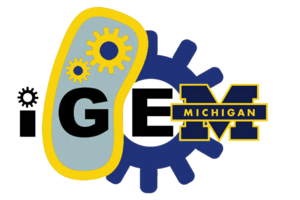Team:Michigan/Project
From 2011.igem.org
(→Surface Display) |
(→DNA-Binding Proteins) |
||
| Line 13: | Line 13: | ||
==DNA-Binding Proteins== | ==DNA-Binding Proteins== | ||
| - | + | The objective of the DNA binding team is to find and characterize DNA binding proteins in order to identify one with 1) the strongest affinity to DNA and 2) a structure that is predicted to tolerate the linker attachment in order to surface display it on Escherichia coli. Our preliminary approach is to use zinc finger motifs as it has been well-known for its strong ability to bind to DNA and there exists a plethora of literature documenting its mechanism and combinations for optimizing binding specificity and affinity. We currently have three zinc finger protein candidates, two freely available from the iGEM Parts Registry and the third is a designer zinc finger described in Jantz et al. 2010. We plan to characterize the binding affinity of our zinc fingers candidates with fluorescence anisotropy assay. For a relatively qualitative assay, we intend to use chemiluminescence (EMSA) to visually detect the binding ability of the zinc finger proteins in a southwestern blot using methods described by Hurt et al. 2003. | |
| - | + | ||
==Microarrays== | ==Microarrays== | ||
Revision as of 20:14, 5 July 2011

Cell Patterning
This year’s project explores developing a cell patterning platform based on oligonucleotide-directed cell binding to substrate surfaces. Our approach entails engineering cells to selectively bind to certain nucleotide sequences (via surface display of DNA binding proteins, such as zinc fingers), allowing for guided assembly of defined cell patterns on surfaces patterned with oligonucleotides.
Surface Display
The goal of the SD team is to identify, construct, and test various surface display systems to support the team's ultimate aim of displaying a Zn-Finger protein on the surface of E. coli. Specifically, we have chosen to focus on systems utilizing OmpA, INP, and AIDA-1, allowing for the use of both established and unestablished BioBrick parts. Currently we are trying to build plasmids to test display by combining promoters, RBS’s, carrier’s, and test display proteins (e.g. GFP). Combining these parts we will be able to build biobricks and test our display systems so that we are ready to attempt surface display for a zinc finger.
DNA-Binding Proteins
The objective of the DNA binding team is to find and characterize DNA binding proteins in order to identify one with 1) the strongest affinity to DNA and 2) a structure that is predicted to tolerate the linker attachment in order to surface display it on Escherichia coli. Our preliminary approach is to use zinc finger motifs as it has been well-known for its strong ability to bind to DNA and there exists a plethora of literature documenting its mechanism and combinations for optimizing binding specificity and affinity. We currently have three zinc finger protein candidates, two freely available from the iGEM Parts Registry and the third is a designer zinc finger described in Jantz et al. 2010. We plan to characterize the binding affinity of our zinc fingers candidates with fluorescence anisotropy assay. For a relatively qualitative assay, we intend to use chemiluminescence (EMSA) to visually detect the binding ability of the zinc finger proteins in a southwestern blot using methods described by Hurt et al. 2003.
Microarrays
Results
 "
"